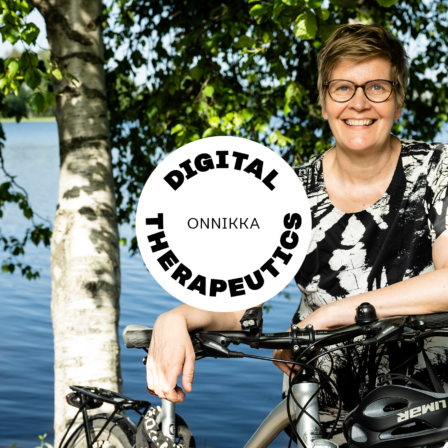The use of digital therapies, such as health apps, as part of treatment and rehabilitation, is growing rapidly. Sitra collected experiences and lessons learned and funded six projects in which patients and nursing staff experimented with the use of apps as part of treatment. The apps are based on medical evidence, which means they are not just ordinary fitness bands.
In Sitra’s trials, for example, asthma patients took measurements at home and reported the results via the app. Cancer patients were able to contact their carers using the app, and sudden changes in their health status could be addressed swiftly. The weight management app guided and encouraged dieters to make small changes. There were also apps for the rehabilitation of patients with musculoskeletal disorders, multiple sclerosis and for monitoring those taking blood thinners.
The results are mainly positive, but some areas for improvement have been identified.
Patients want more apps for managing their health
The clearest finding since the start of the trials has been the huge demand from patients for new apps, such as those tested in the pilots. Patients with chronic conditions were strongly represented in the trials. These patients are often well-informed about their own health, their conditions and treatments. The inconvenience of using the apps, for example for recording symptoms on a daily basis, was not felt to be not a problem as long as the apps are helpful.
But the benefits of many apps are not immediately obvious to patients, which highlights the need for apps to be straightforward to operate. It is easy to stop using a complex app and miss out on the benefits.
Some patients need support while others need to continue to receive health services in the traditional way. Old age and a combination of several conditions were identified as a challenge in several of the trials. This was not the case in the Siun Sote pilot, where the average age of the cancer patients involved was 68. The advanced age of the patients did not cause any difficulties in using the apps piloted. Many patients receive support from their loved ones in using the app. Some of the apps used were in the development phase, so the problems did not come as a surprise.
The use of digital therapies allows traditional care to focus on patients with multiple conditions and those who are unable to use apps. By effectively treating younger and healthier patients using new methods, more resources are available for the better care of patients who require more attention.
Professionals welcome app use
Before the projects started, we thought that health professionals might be reluctant to use the apps. This turned out to be completely wrong. In some trials, we even had to put the brakes on the roll-out of apps to avoid running out of reserved licences at the start of the project. It is important, however, that the digital therapies do not add to the workload of nursing staff after initial training and learning.
Nursing staff have a vital role in engage patients in using digital therapies. People in Finland trust healthcare professionals and listen to their advice. The threshold for professionals to recommend a digital app is high. It is therefore important to clearly describe the clinical evidence and to educate and support professionals in the use of the app so that patients are also given specialist information.
You might also be interested in
Integrating an app with the patient information system depends on the nature of the app being used. If a digital app works like a medicine, there is no need for integration is needed. If the app is part of the normal work, integration is an absolute necessity.
Implementation requires resources from the healthcare system – cost savings come with a time lag
It is often assumed that digital therapies overcome problems by themselves. But this is rarely the case. The operating models and work flows need to be developed and adapted to reap the full benefits of digital therapies.
Changes to the operating model may be small, but sometimes a larger, organisation-wide change is needed. In the Siun Sote pilot, the digital care pathway means moving from a calendar-based, professional-initiated approach to a symptom-based, patient-driven model: the patient is invited to the clinic when changes in their condition are detected. In the Central Finland weight management pilot, it was possible to start the trial with very few changes to the way the app works, because it works as a stand-alone treatment.
Much of the debate about public health care in Finland concerns costs. Digital forms of care do not necessarily reduce costs, or the savings are reflected elsewhere or with a time lag. But service quality and outcomes are important factors in quality healthcare. Some of the apps used in the trial have been proposed for further use, although they do not directly contain costs. Preventive solutions can raise costs in the short term but reduce the need for services later.
We need a broader assessment of costs. The use of a digital app may increase costs in the care unit but decrease costs in an inpatient unit because the patient is discharged sooner. Some of the knock-on effects may be too broad and affect actors other than the well-being services county. For example, improved health status may allow patients to return to work, but the cost savings are felt elsewhere, not directly in the economy of the well-being services county. On the other hand, time saved does not reduce costs unless the working time freed up can be reallocated or staff resources reduced. The important measure is the working time and cost per patient, not working time or the cost of the whole care organisation.
Digital therapies can make management and organisation easier. When some patients are treated digitally, the necessary professional resources can be taken from another unit, regardless of distance. This makes it easier to make up for absences due to sickness.
Open collaboration and change management pay off
Procurement and deployment involve many non-treatment related tasks that have a decisive impact on the final outcome. Having a designated person in charge is a prerequisite for success. Training, producing guidelines, communication, liaison with the apps supplier and practical arrangements require work and planning that is almost impossible to do in parallel with the core work.
There is a need for discussion and open communication at all levels of the organisation. It is good for frontline staff to consider approaches together. Communication between units is also important. Insights and good practices should be shared and further developed. Staff should be involved in the planning process at an early stage.
Phased implementation was found to be a good practice. Starting from a single unit makes it easier to solve problems. This allows for learning and problems to be solved before they affect the whole organisation. Failures or setbacks can substantially delay the roll out of apps. The software and operating model associated with the app can be adapted to better suit the organisation in the early stages.
Interaction with the system supplier should be kept open. It is not possible to buy healthcare apps like telephones or medical equipment. Modifications and customisation are always needed. This should be anticipated at the procurement stage, and sufficient time, resources, and budget should be allocated.
Sitra funded six digital therapy trials in Finland 2022–2023
Digital therapies are here to stay. At their best, they make everyday life easier for patients and nursing staff. Health services can access up-to-date information from the apps, and patients don’t always have to go to the health centre. On the other hand, if a risk situation arises, the apps can alert medical staff to call the patient for an urgent check-up or to adjust medication. There will also be cost savings as the use of the system becomes more established.
We recommend
Have some more.















